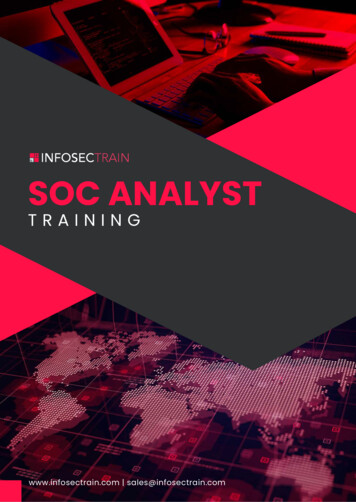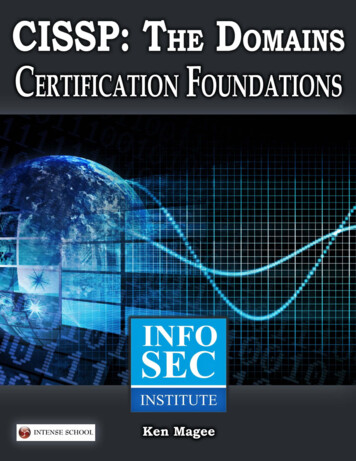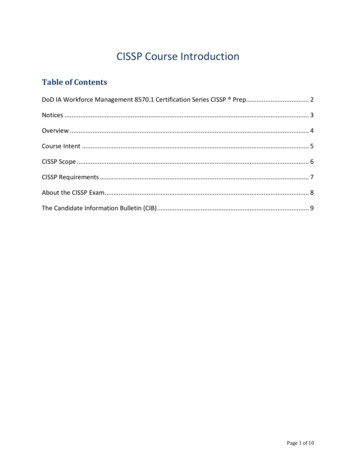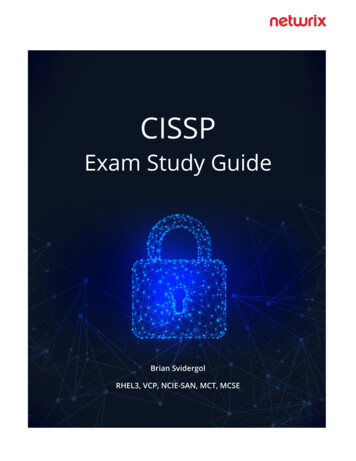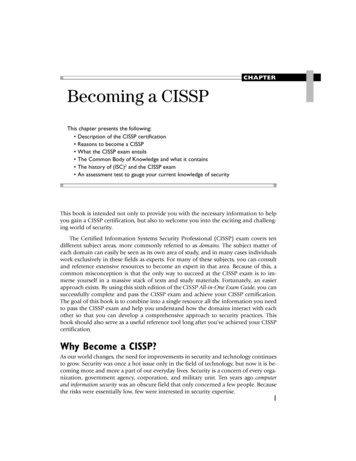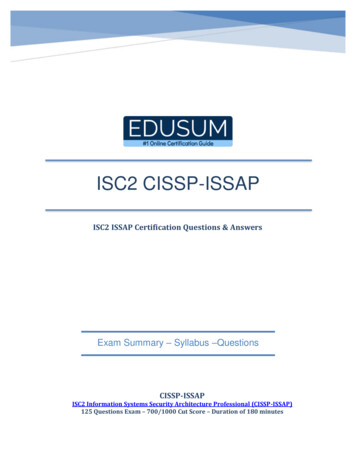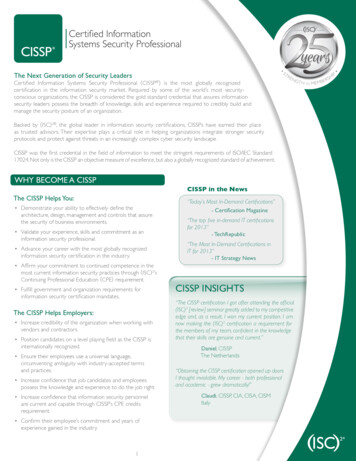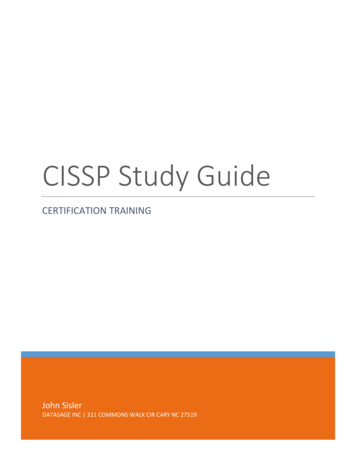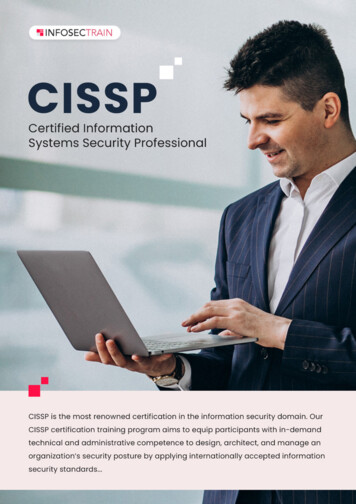
Transcription
CISSP IntroductionCISSP is the most renowned certification in the information security domain. OurCISSP certification training program aims to equip participants with in-demandtechnical and administrative competence to design, architect, and manage anorganization’s security posture by applying internationally accepted informationsecurity standards. The training offers an in-depth understanding of eightdomains that comprise CISSP common body knowledge (CBK) and prepares youfor the CISSP exam held by the (ISC)2.(ISC)² is a globally recognized, nonprofit organization dedicated to advancingthe information security field. The CISSP was the first credential in informationsecurity to meet the stringent requirements of ISO/IEC Standard 17024. It is lookedupon as an objective measure of excellence and a highly reputedstandardof achievement.www.infosectrain.com sales@infosectrain.com01
Why CISSP with InfosecTrain4 hrs/ day inWeekend/ WeekdayAccreditedInstructorsOnline Test simulationmapped with domainsFull 8 Domain ExamPracticeAccess to therecorded sessionsCISSPExam engineTelegram Discussion Groupwww.infosectrain.com sales@infosectrain.com02
Our Expert InstructorsCertified Security specialist having several years of experience in Information Security across alldomains including application security, vulnerability assessment, ethical hacking, pen testing andIT risk and compliance and morePRABH NAIRCISSP I CCSP I CSSLP ICRISC I CISM I CISA I CGEITCAjit has more than 15 years of experience which include Consulting, Network and InfoSec training( CISA, CISM, CISSP, CCSP, Security , SSCP), Content development, Assessments and auditing andmoreAJITCISSP I CCSP I CRISC I CISA I CGEITCPrashant is a seasoned Information Security professional with 10 years of hands on experience inauditing application controls, identifying breaches, communicating gaps and risks to the businessand providing solutions in accordance with the policy to the stakeholders.PRASHANT MCISSP I CCSP I CRISC CISAAfter having worked for 20 years in IT, Cyber Security and Consulting, Mathew Ford is enjoying hisnew career as a Cyber Security instructor. He always knew he will be a teacher and working inInfoSec Train is like a breath of fresh air for him!MATTHEW FORDCISSP I CISMwww.infosectrain.com sales@infosectrain.com03
Happy Learners from LinkedInHappy Learners from the worldPaul EbenezerSenior Consultant United KingdomEmily KongIT Security JapanInfosec Train has an amazing coach, mentor,and a great personality, one of the best ITI had the opportunity to take CISSP lessons. TheSecurity and Technology trainers that currentlyTrainer has been consistently giving me a lot ofexists. Trainer's dedication to teach and sharemental and material support. I wouldknowledge, commitment.recommend his mentorship for any aspirant.Mohit TrehanSmitha KurupCISSP USAI made the right choice, and every session wasworth it. Thank you once again. I would highlyrecommend my friends, the professor hasimmense knowledge and the subject and wasvery logical and practical.www.infosectrain.com sales@infosectrain.comCISSP UAETrainer organized the CISSP training session in awell-organized way. Overall Experience with thetrainer and the provided training material wasExcellent. All the CISSP sessions are veryin-formative and had an explicit knowledge of howto accomplish the certification.04
Security and RiskManagementSoftwareDevelopmentSecurityAsset Security81Security7CISSP2Architectureand essmentand Testingwww.infosectrain.com sales@infosectrain.com4Communicationand NetworkSecurityIdentity andAccessManagement(IAM)05
Domain 1: Security and Risk Management1.1 Understand and apply concepts of confidentiality, integrity and availability1.2 Evaluate and apply security governance principles Alignment of security function to business strategy, goals, mission, andobjectives Organizational processes (e.g., acquisitions, divestitures, governancecommittees) Organizational roles and responsibilities Security control frameworks Due care/due diligence1.3 Determine compliance requirements Contractual, legal, industry standards, and regulatory requirements Privacy requirements1.4 Understand legal and regulatory issues that pertain to information securityin a global context Cyber crimes and data breaches Trans-border data flow Licensing and intellectual propertyrequirements Privacy Import/export controls1.5 Understand, adhere to, and promote professional ethics (ISC)² Code of Professional Ethics Organizational code of ethics1.6 Develop, document, and implement security policy, standards, procedures,and guidelines1.7 Identify, analyze, and prioritize Business Continuity (BC) requirements Develop and document scope and plan Business Impact Analysis (BIA)www.infosectrain.com sales@infosectrain.com06
1.8 Contribute to and enforce personnel security policies and procedures Candidate screening and hiring Compliance policy requirements Employment agreements and policies Privacy policy requirements Onboarding and termination processes Vendor, consultant, and contractoragreements and controls1.9 Understand and apply risk management concepts Identify threats and vulnerabilities Risk assessment/analysis Security Control Assessment(SCA) Risk response Monitoring and measurement Countermeasure selection andimplementation Asset valuation Reporting Applicable types of controls (e.g.,preventive, detective, corrective) Continuous improvement Risk frameworks1.10 Understand and apply threat modeling concepts and methodologies Threat modeling methodologies Threat modeling concepts1.11 Apply risk-based management concepts to the supply chain Risks associated with hardware, software, and services Third-party assessment and monitoring Minimum security requirements Service-level requirements1.12 Establish and maintain a security awareness, education, and training program Methods and techniques to present awareness and training Periodic content reviews Program effectiveness evaluationwww.infosectrain.com sales@infosectrain.com07
Domain 2: Asset Security2.1 Identify and classify information and assets Data classification Asset Classification2.2 Determine and maintain information and asset ownership2.3 Protect privacy Data owners Data remanence Data processers Collection limitation2.4 Ensure appropriate asset retention2.5 Determine data security controls Understand data states Standards selection Scoping and tailoring Data protection methods2.6 Establish information and asset handling requirementswww.infosectrain.com sales@infosectrain.com08
Domain 3: Security Architecture and Engineering3.1 Implement and manage engineering processes using secure design principles3.2 Understand the fundamental concepts of security models3.3 Select controls based upon systems security requirements3.4 Understand security capabilities of information systems (e.g., memoryprotection, Trusted Platform Module (TPM), encryption/decryption)3.5 Assess and mitigate the vulnerabilities of security architectures, designs,and solution elements Client-based systems Industrial Control Systems (ICS) Server-based systems Cloud-based systems Database systems Distributed systems Cryptographic systems Internet of Things (IoT)3.6 Assess and mitigate vulnerabilities in web-based systems3.7 Assess and mitigate vulnerabilities in mobile systems3.8 Assess and mitigate vulnerabilities in embedded devices3.9 Apply cryptography Cryptographic life cycle (e.g.,key management, algorithmselection) Digital signatures Cryptographic methods (e.g.,symmetric, asymmetric, ellipticcurves) Understand methods ofcryptanalytic attacks Public Key Infrastructure (PKI) Non-repudiation Integrity (e.g., hashing) Digital Rights Management (DRM) Key management practices3.10 Apply security principles to site and facility designwww.infosectrain.com sales@infosectrain.com09
3.11 Implement site and facility security controls Wiring closets/intermediate distribution facilities Server rooms/data centers Media storage facilities Evidence storage Restricted and work area security Utilities and Heating, Ventilation, and Air Conditioning (HVAC) Environmental issues Fire prevention, detection, and suppressionwww.infosectrain.com sales@infosectrain.com10
Domain 4: Communication and Network Security4.1 Implement secure design principles in network architectures Open System Interconnection (OSI)and Transmission ControlProtocol/Internet Protocol (TCP/IP)models Converged protocols Software-defined networks Wireless networks Internet Protocol (IP) networking Implications of multilayer protocols4.2 Secure network components Operation of hardware Endpoint security Transmission media Content-distribution networks Network Access Control (NAC)devices4.3 Implement secure communication channels according to design Voice Data communications Multimedia collaboration Virtualized networks Remote accesswww.infosectrain.com sales@infosectrain.com11
Domain 5: Identity and Access Management ( IAM)5.1 Control physical and logical access to assets Information Devices Systems Facilities5.2 Manage identification and authentication of people, devices, and services Identity management implementation Registration and proofing of identity Single/multi-factor authentication Federated Identity Management(FIM) Accountability Session management Credential management systems5.3 Integrate identity as a third-party service On-premise Cloud Federated5.4 Implement and manage authorization mechanisms Role Based Access Control (RBAC) Discretionary Access Control (DAC) Rule-based access control Attribute Based Access Control(ABAC) Mandatory Access Control (MAC)5.5 Manage the identity and access provisioning lifecycle User access review System account access review Provisioning and deprovisioningwww.infosectrain.com sales@infosectrain.com12
Domain 6: Security Assessment and Testing6.1 Design and validate assessment, test, and audit strategies Internal External Third-party6.2 Conduct security control testing Vulnerability assessment Code review and testing Penetration testing Misuse case testing Log reviews Test coverage analysis Synthetic transactions Interface testing6.3 Collect security process data (e.g., technical and administrative) Account management Training and awareness Management review and approval Disaster Recovery (DR) andBusiness Continuity (BC) Key performance and risk indicators Backup verification data6.4 Analyze test output and generate report6.5 Conduct or facilitate security audits Internal External Third-partywww.infosectrain.com sales@infosectrain.com13
Domain 7: Security Operations7.1 Understand and support investigations Evidence collection and handling Investigative techniques Reporting and documentation Digital forensics tools, tactics, andprocedures7.2 Understand requirements for investigation types Administrative Regulatory Criminal Industry standards Civil7.3 Conduct logging and monitoring activities Intrusion detection and prevention Continuous monitoring Security Information and EventManagement (SIEM) Egress monitoring7.4 Securely provisioning resources Asset inventory Asset management Configuration management7.5 Understand and apply foundational security operations concepts Need-to-know/least privileges Separation of duties andsponsibilities Job rotationre- Privileged account management Information lifecycle Service Level Agreements (SLA)7.6 Apply resource protection techniques Media management Hardware and software asset managementwww.infosectrain.com sales@infosectrain.com14
7.7 Conduct incident management Detection Recovery Response Remediation Mitigation Lessons learned Reporting7.8 Operate and maintain detective and preventative measures Firewalls Sandboxing Intrusion detection and preventionsystems Honeypots/honeynets Whitelisting/blacklisting Anti-malware Third-party provided security services7.9 Implement and support patch and vulnerability management7.10 Understand and participate in change management processes7.11 Implement recovery strategies Backup storage strategies Recovery site strategies Multiple processing sites System resilience, highavailability, Quality ofService (QoS), and faulttolerance7.12 Implement Disaster Recovery (DR) processes Response Assessment Personnel Restoration Communications Training and awareness7.13 Test Disaster Recovery Plans (DRP) Read-through/tabletop Parallel Walkthrough Full interruption Simulation7.14 Participate in Business Continuity (BC) planning and exercises7.15 Implement and manage physical security Perimeter security controls Internal security controlswww.infosectrain.com sales@infosectrain.com15
7.16 Address personnel safety and security concerns Travel Security training and awareness Emergency management Duresswww.infosectrain.com sales@infosectrain.com16
Domain 8: Software Development Security8.1 Understand and integrate security in the Software Development Life Cycle (SDLC) Development methodologies Change management Maturity models Integrated product team Operation and maintenance8.2 Identify and apply security controls in development environments Security of the software environments Configuration management as an aspect of secure coding Security of code repositories8.3 Assess the effectiveness of software security Auditing and logging of changes Risk analysis and mitigation8.4 Assess security impact of acquired software8.5 Define and apply secure coding guidelines and standards Security weaknesses and vulnerabilities at the source-code level Security of application programming interfaces Secure coding practiceswww.infosectrain.com sales@infosectrain.com17
www.infosectrain.com sales@infosectrain.com
domains that comprise CISSP common body knowledge (CBK) and prepares you for the CISSP exam held by the (ISC)2. (ISC)² is a globally recognized, nonprofit organization dedicated to advancing the information security field. The CISSP was the first credential in information security to m
